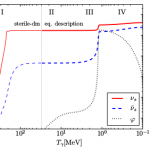Paper of the month: Sterile Neutrinos as DM candidates

February 21, 2018 by RebecaBV
For particle physicists the important question is how these sterile neutrinos could be detected and distinguished from other Dark Matter candidates. A sterile neutrino can decay into a Standard Model-neutrino and a photon. Fortunately, the rate and energy of this process are in reach of current and future X-ray telescopes. In 2014, the observation of an unassociated X-ray line at 3.5 keV, with an intensity that fits the expectation for this decay, produced much commotion in the field. In the meantime, considerations related to structure formation in the Universe, as well as bounds derived from X-ray observations, have strongly increased the constraints on models involving sterile neutrinos produced through oscillations.
A mechanism proposed in Ref.[1] solves some of the tensions between the predictions of the sterile neutrino-models and X-ray observations. The main ingredient of this mechanism are interactions of the sterile neutrinos with a new kind of boson, which is taken to be heavier than the sterile neutrinos. This new kind of interaction would allow the sterile neutrinos generated via oscillations (in Figure 1, see epoch I) to produce heavy bosons, which could thermalise relatively quickly through “number changing processes” such as 2ϕ ↔ 4ϕ (in Figure 1, see epoch II).
If the heavy boson-production mechanism is efficient enough, the inverse process, producing sterile neutrinos from heavy bosons, drives the sterile neutrinos towards equilibrium (epoch III).
As the Universe expands, it cools and with it the heavy bosons. They become non-relativistic and start to annihilate with each other, or decay into sterile neutrinos (epoch IV).
.png)
Figure 1: Thermalisation of the dark sector species. This figure, taken from Ref.[1], shows the simulated abundances of the sterile neutrinos νs, of their antiparticles ¯ νs and of the new heavy boson ψ as a function of the photon-temperature Tγ in the early universe. (The photon-temperature is a measure of the temperature of the Universe as a whole, and thus of the time since the (hot) Big Bang.) The epochs I-IV correspond to the four stages of the mechanism described in the text.
In comparison with conventional sterile neutrino-models, the model proposed in Ref.[1] leads to a larger sterile neutrino-abundance and lower sterile neutrinovelocities, as desired by the Dark Matter model builders. We can safely say that story of the sterile neutrino as a Dark Matter-candidate is not over yet.
[1] R. S. L. Hansen and S. Vogl, Thermalizing sterile neutrino dark matter, Phys. Rev. Lett. 119, 251305 (2017), arXiv:1706.02707
Text by Nuno Rosa (University of Barcelona) and Fiona Kirk (Georg-August-Universitaet Goettingen Stiftung Oeffentlichen Rechts UGOE)


